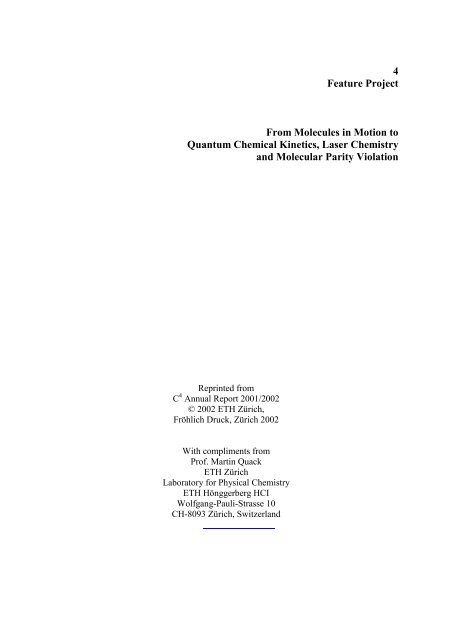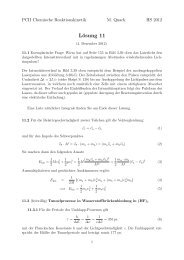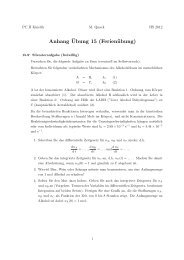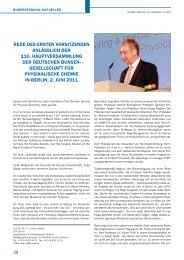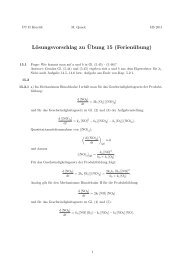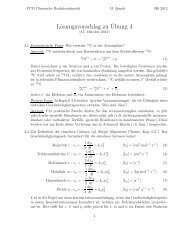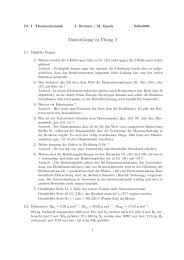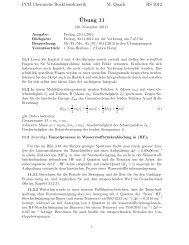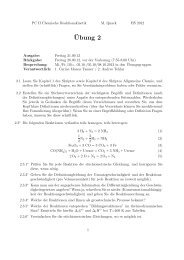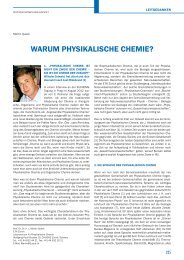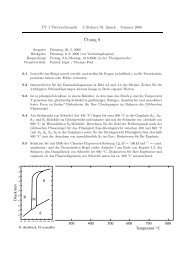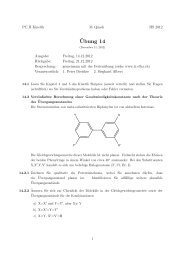Molecules in Motion - Quack - ETH Zürich
Molecules in Motion - Quack - ETH Zürich
Molecules in Motion - Quack - ETH Zürich
You also want an ePaper? Increase the reach of your titles
YUMPU automatically turns print PDFs into web optimized ePapers that Google loves.
4<br />
Feature Project<br />
From <strong>Molecules</strong> <strong>in</strong> <strong>Motion</strong> to<br />
Quantum Chemical K<strong>in</strong>etics, Laser Chemistry<br />
and Molecular Parity Violation<br />
Repr<strong>in</strong>ted from<br />
C 4 Annual Report 2001/2002<br />
© 2002 <strong>ETH</strong> <strong>Zürich</strong>,<br />
Fröhlich Druck, <strong>Zürich</strong> 2002<br />
With compliments from<br />
Prof. Mart<strong>in</strong> <strong>Quack</strong><br />
<strong>ETH</strong> <strong>Zürich</strong><br />
Laboratory for Physical Chemistry<br />
<strong>ETH</strong> Hönggerberg HCI<br />
Wolfgang-Pauli-Strasse 10<br />
CH-8093 <strong>Zürich</strong>, Switzerland
Researchers: Sieghard Albert, Michael Gottselig, Michael Hippler, Hans Hollenste<strong>in</strong>,<br />
Roberto Marquardt, Lars Oeltjen, Mart<strong>in</strong> <strong>Quack</strong>, Heiko Schmid, Georg<br />
Seyfang, Achim Sieben, Jürgen Stohner, Mart<strong>in</strong> Willeke<br />
Institute/<br />
Group<br />
Group for Molecular K<strong>in</strong>etics and Spectroscopy (Mart<strong>in</strong> <strong>Quack</strong>)<br />
Laboratory for Physical Chemistry, <strong>ETH</strong> <strong>Zürich</strong><br />
Abstract<br />
The group for molecular k<strong>in</strong>etics and spectroscopy at <strong>ETH</strong> <strong>Zürich</strong> <strong>in</strong>vestigates the<br />
fundamental physical-chemical primary processes of chemical reactions. We have developed<br />
a conceptually new approach to derive these primary processes of <strong>in</strong>tramolecular k<strong>in</strong>etics on<br />
time scales lead<strong>in</strong>g <strong>in</strong>to the femtosecond and subfemtosecond (attosecond) doma<strong>in</strong> on the<br />
basis of <strong>in</strong>frared spectroscopy with high frequency resolution but without short-time<br />
resolution. Selected applications <strong>in</strong>clude <strong>in</strong>tramolecular quantum wavepacket dynamics of<br />
chemical functional groups of isolated, <strong>in</strong>dividual molecules and IR-laser chemistry of<br />
molecules under <strong>in</strong>frared multiphoton excitation, hydrogen bond tunnel<strong>in</strong>g dynamics <strong>in</strong><br />
hydrogen fluoride clusters (HF) 2 and the tunnel<strong>in</strong>g stereomutation of prototypical chiral<br />
molecules. One of the greatest current challenges is the elucidation of the <strong>in</strong>fluence of the<br />
parity violat<strong>in</strong>g weak <strong>in</strong>teraction mediated by the Z-Boson of high energy physics on the<br />
dynamics of chiral molecules. While the Z-Boson has a lifetime of less than a yoctosecond<br />
(10 -24 s), the time scales for molecular parity violation are calculated to fall <strong>in</strong> the range of<br />
seconds. These processes of molecular parity violation can be compared to the processes of<br />
tunnel<strong>in</strong>g stereomutation <strong>in</strong> chiral molecules which extend from the femtosecond time scale to<br />
times that exceed the age of the universe by many orders of magnitude.<br />
1. Introduction: Molecular K<strong>in</strong>etics and Spectroscopy from the Schröd<strong>in</strong>ger equation<br />
and quantum chemical k<strong>in</strong>etics<br />
We have developed a conceptually new approach to <strong>in</strong>vestigate fast <strong>in</strong>tramolecular primary<br />
processes with effective time resolutions reach<strong>in</strong>g about 0.2 fs (200 as = 2 x 10 -16 s) <strong>in</strong><br />
practice, and even better, <strong>in</strong> pr<strong>in</strong>ciple [1-12]. This approach starts out from high frequency<br />
resolution spectroscopy of polyatomic molecules (but no, or unimportant time resolution) to<br />
derive the true molecular quantum motion at short time, either <strong>in</strong> isolation [12] or with strong<br />
laser irradiation, which may control molecular motion [13]. The method of analysis is the<br />
time dependent (and time <strong>in</strong>dependent) Schröd<strong>in</strong>ger equation (<strong>in</strong> modern notation – very<br />
similar to the orig<strong>in</strong>al one [14]), Eq. (1), solved by Eq. (2). Obviously, the approach makes<br />
use of substantial computation <strong>in</strong> several steps of the analysis.<br />
h (<br />
q,<br />
t)<br />
i<br />
2<br />
t<br />
Ĥ (q,t)<br />
(1)<br />
(q,t) U ˆ ( t,<br />
t0 ) (q,t0<br />
)<br />
(2)<br />
- 2 -
Fig. 1: Scheme to derive fundamental processes of molecular k<strong>in</strong>etics from high resolution<br />
spectroscopy (after [12]).<br />
The general, somewhat abstract scheme is outl<strong>in</strong>ed <strong>in</strong> Fig. 1. Molecular <strong>in</strong>frared spectra<br />
consist of many thousands of l<strong>in</strong>es whose positions and <strong>in</strong>tensities can be accurately<br />
measured. Their analysis provides <strong>in</strong> several complicated steps the molecular hamiltonian<br />
operator ( Ĥ <strong>in</strong> Eq. (1), from which the time evolution operator (U ˆ <strong>in</strong> Eq. (2)) and the time<br />
dependent wavefunction Ψ(q, t) are derived. Ψ(q, t) conta<strong>in</strong>s all the relevant <strong>in</strong>formation on<br />
the time dependent molecular motion <strong>in</strong> the complete coord<strong>in</strong>ate space (q). The experimental<br />
results can be compared with theoretical results derived from ab <strong>in</strong>itio hamiltonians, which<br />
may also aid the analysis of experiments. For a detailed outl<strong>in</strong>e of this approach we refer to<br />
[9-13, 15-17]. We shall present here some exemplary applications.<br />
- 3 -
2. Molecular Multiphoton Excitation and Infrared Laser Chemistry<br />
These are new areas of chemical k<strong>in</strong>etics, where the analysis can either follow the traditional<br />
rate equation approach or the quantum chemical k<strong>in</strong>etics – Schröd<strong>in</strong>ger equation (1)<br />
approaches. Indeed, it can be shown on the basis of the fundamental Schröd<strong>in</strong>ger equation,<br />
under which conditions and <strong>in</strong> which form the rate equation approach may apply [13, 18]. The<br />
method consists <strong>in</strong> excit<strong>in</strong>g molecular vibrations with many (typically between 10 and 50, but<br />
up to 500 or more) <strong>in</strong>frared photons. Typical times are between 1 ns and 500 ns. Recent<br />
applications concern the reactions of organic iodides such as<br />
12,13<br />
12,13<br />
2<br />
CF3<br />
I nh <br />
CF3<br />
I ( P3 / 2<br />
, F 1,2,3,4) ( n 20)<br />
(3)<br />
where for the first time the distribution of products over different hyperf<strong>in</strong>e levels (F = 1, 2, 3,<br />
4) could be measured and was found to be statistical, as is the product translational and<br />
<strong>in</strong>ternal energy on ns to ps time scales [19]. Computer simulations are used to analyze these<br />
results.<br />
Another example is C 60 , which after multiphoton excitation with about 500 <strong>in</strong>frared photons<br />
shows vibrational preionization, demonstrated for the first time for a neutral molecule <strong>in</strong> our<br />
work on this example [20]<br />
and subsequent fragmentation<br />
nhν<br />
<br />
60 60<br />
<br />
C C e<br />
n 500<br />
(4)<br />
nhν<br />
<br />
60<br />
<br />
58<br />
<br />
2<br />
<br />
56<br />
2C2<br />
C C C C<br />
etc. (5)<br />
This reaction sequence could be analyzed quantitatively by extensive master equation<br />
simulations follow<strong>in</strong>g “case B” k<strong>in</strong>etics (see [4, 13].<br />
Another <strong>in</strong>terest<strong>in</strong>g reaction was <strong>in</strong>vestigated <strong>in</strong> order to establish the transition between<br />
“case B” master equation k<strong>in</strong>etics and “case C” master equation k<strong>in</strong>etics [4, 13] as a function<br />
of molecular preexcitation [45]:<br />
'<br />
hν<br />
* nhν<br />
3<br />
<br />
3<br />
<br />
3<br />
(6)<br />
CH OH CH OH CH OH<br />
In this reaction sequence, <strong>in</strong> a first step an <strong>in</strong>frared laser is used to preexcite the methanol<br />
molecule with one or several quanta of the OH stretch<strong>in</strong>g vibration (fundamental or overtone<br />
transition with hν). Subsequently the thus preexcited methanol CH 3 OH * is further excited<br />
with n photons of a CO 2 laser to f<strong>in</strong>ally be dissociated <strong>in</strong>to CH 3 + OH. Depend<strong>in</strong>g on the<br />
degree of preexcitation, nonl<strong>in</strong>ear case C effects are more or less pronounced <strong>in</strong> the second<br />
step of multiphoton excitation. The nonl<strong>in</strong>ear effects on this laser chemical reaction could be<br />
simulated quantitatively by the case C – case B master equation approach [4, 13, 45].<br />
The most <strong>in</strong>terest<strong>in</strong>g fundamental questions <strong>in</strong> this k<strong>in</strong>d of k<strong>in</strong>etics concern the role of<br />
<strong>in</strong>termolecular selectivity and of <strong>in</strong>tramolecular selectivity as outl<strong>in</strong>ed <strong>in</strong> Fig. 2.<br />
- 4 -
Intermolecular selectivity of the highly monochromatic laser excitation implies that we are<br />
able to select <strong>in</strong> a reaction mixture the molecules we desire for a chemical reaction. In<br />
particular, one can select different isotopomers of the same molecule (such as 12 C or 13 C <strong>in</strong><br />
Eq. (4) and the method can be used rather rout<strong>in</strong>ely for efficient isotope separation follow<strong>in</strong>g<br />
several schemes [21-23]. Today there is still hardly a useful market for the use of such<br />
isotopes, but once such a market evolves (for <strong>in</strong>stance with potential medical applications of<br />
13 C), the method can be made a start<strong>in</strong>g po<strong>in</strong>t for an <strong>in</strong>dustrial process.<br />
In contrast to <strong>in</strong>termolecular selectivity <strong>in</strong> a mixture of molecules, <strong>in</strong>tramolecular selectivity<br />
would allow us to do some k<strong>in</strong>d of selective molecular “laser surgery” with<strong>in</strong> a s<strong>in</strong>gle,<br />
isolated molecule (Fig.2). It turns out that the realization of this dream of “mode selective<br />
chemistry” requires a deeper knowledge of <strong>in</strong>tramolecular processes.<br />
Fig. 2: Intermolecular and <strong>in</strong>tramolecular selectivity <strong>in</strong> laser chemistry (after [21]).<br />
- 5 -
3. Intramolecular vibrational redistribution and quantum wavepacket motion for the<br />
dynamics of functional groups<br />
What happens <strong>in</strong> a molecule upon local excitation of an <strong>in</strong>frared chromophore (Fig.2)? How<br />
does the energy migrate from one part of the molecule to another? How do molecules really<br />
move? These questions are at the start<strong>in</strong>g po<strong>in</strong>t of chemical reaction k<strong>in</strong>etics and shall be<br />
answered here for the fundamental example of just two coupled molecular vibrational modes<br />
<strong>in</strong> organic molecules o the type HCX 3 , where for short times (up to 1 ps) just the C–H bond<br />
stretch<strong>in</strong>g and the C–H bend<strong>in</strong>g vibration exchange excitation energy. The quantum motion<br />
can be described by a two dimensional potential similar to a bathtub, with equipotential l<strong>in</strong>es<br />
of the same potential energy be<strong>in</strong>g depicted <strong>in</strong> Fig. 3 [24]. One may consider the description<br />
of quantum motion like “waves <strong>in</strong> this bathtub”, where the absolute square of the wave<br />
function (|Ψ| 2 ) gives the probability density of the position of the H-atom along a stretch<strong>in</strong>g or<br />
bend<strong>in</strong>g direction. There have been <strong>in</strong> the past two fundamentally different descriptions. In<br />
the first, the excitation rema<strong>in</strong>s localized <strong>in</strong> one or the other direction of motion (pictures N <strong>in</strong><br />
Fig. 3, for “normal mode description”), depend<strong>in</strong>g on the <strong>in</strong>itial excitation, perhaps with slow,<br />
periodic exchange between the two directions of motion.<br />
Fig. 3: Scheme of equipotential l<strong>in</strong>es and probability distributions <strong>in</strong> a model of two coupled<br />
molecular vibrational modes.<br />
In the other description, S <strong>in</strong> Fig. 3 (it forms the basis of statistical theories like the transition<br />
state theory of chemical k<strong>in</strong>etics), the excitation is delocalized on the average over the whole<br />
energetically accessible coord<strong>in</strong>ate range. Fig. 4 shows how for the molecule CHF 3 an <strong>in</strong>itial<br />
pure stretch<strong>in</strong>g excitation (0 fs) spreads over the whole coord<strong>in</strong>ate range of stretch<strong>in</strong>g and<br />
bend<strong>in</strong>g <strong>in</strong> less than 100 fs. The probability densities |Ψ| 2 really look like waves cover<strong>in</strong>g the<br />
whole bathtub. The <strong>in</strong>terpretation gives a loss of localized structure <strong>in</strong> addition to energy<br />
migration, a typical quantum mechanical effect [11, 25, 26]. While the result shown here<br />
dates back some time and is, <strong>in</strong>deed, the very first experimentally derived multidimensional<br />
molecular femtosecond wavepacket for energy migration, there have been numerous results<br />
s<strong>in</strong>ce then, show<strong>in</strong>g very different behaviour for this wavepacket evolution for different<br />
functional groups <strong>in</strong> molecules, for <strong>in</strong>stance the R–C≡C–H group leads to rather long lived<br />
C–H stretch<strong>in</strong>g excitations with relatively slow energy migration (10 ps to 1 ns) and further<br />
<strong>in</strong>terest<strong>in</strong>g phenomena are observed for chiral XYZCH [27-29], aldehydic C–H <strong>in</strong> R–CHO<br />
[30, 58] and other characteristic chemical environments [15-17, 27, 28].<br />
- 6 -
Fig. 4: Wavepacket motion for the two strongly coupled CH–stretch<strong>in</strong>g (Q s ) and CH–<br />
bend<strong>in</strong>g (Q b ) vibrations <strong>in</strong> the CHF 3 molecule |Ψ(Q s , Q b , t)| 2 is the probability<br />
distribution on the fs time scale after <strong>in</strong>itial CH–stretch<strong>in</strong>g excitation at t = 0<br />
(after [11])<br />
- 7 -
The discovery of mode selective energy migration [25-28] has opened numerous avenues for<br />
future studies. It is expected to replace old dogmas related to the transition state theory of<br />
chemical reactions and may allow the design of <strong>in</strong>tramolecular energy transport <strong>in</strong> the future.<br />
For a recent general review of this subject we refer to [11]. Important recent developments<br />
concern the understand<strong>in</strong>g of the C–H stretch<strong>in</strong>g and –O–H stretch<strong>in</strong>g mode coupl<strong>in</strong>gs <strong>in</strong><br />
highly excited methanol isotopomers such as CHD 2 –OH [46] as well as the –OH and –C–H<br />
stretch<strong>in</strong>g coupl<strong>in</strong>g <strong>in</strong> formic acid [47]. Formic acid is an <strong>in</strong>terest<strong>in</strong>g case for several reasons.<br />
Firstly, we have shown <strong>in</strong> earlier work that formic acid <strong>in</strong> addition to exist<strong>in</strong>g as monomer<br />
can form two types of hydrogen bonded dimer, one (well established) closed form with two<br />
hydrogen bonds, one (newly observed) open form, with one hydrogen bond [8, 48].<br />
Vibrational energy migration <strong>in</strong> these dimers can be studied by <strong>in</strong>frared and visible overtone<br />
spectroscopy and allows one to see effects from tun<strong>in</strong>g Fermi-Resonances by tun<strong>in</strong>g the OH<br />
stretch<strong>in</strong>g frequencies through hydrogen bond<strong>in</strong>g, although it turns out that detailed analysis<br />
of these spectra is difficult [49] and presumably requires guidance through ab <strong>in</strong>itiocalculations.<br />
4. Tunnel<strong>in</strong>g reaction dynamics <strong>in</strong> hydrogen bonds of (HF) n complexes and <strong>in</strong> the<br />
stereomutation of simple chiral molecules<br />
The quantum mechanical tunnel effect plays an important role <strong>in</strong> many areas of atomic and<br />
molecular physics and is expected to be particularly prom<strong>in</strong>ent <strong>in</strong> chemistry, whenever<br />
hydrogen atoms are <strong>in</strong>volved <strong>in</strong> a reaction. It was discovered just 75 years ago at the dawn of<br />
modern quantum mechanics by Friedrich Hund [50]. As a first prototypical example studied<br />
by the spectroscopic approach described <strong>in</strong> Fig. 1 we mention hydrogen bond dissociation and<br />
rearrangement dynamics <strong>in</strong> hydrogen bonded (HF) 2 :<br />
0<br />
(7)<br />
. 0 . 0 .<br />
and<br />
0<br />
. 0<br />
(8)<br />
<br />
. . 0<br />
<br />
.<br />
0<br />
<br />
These processes are of fundamental importance for our understand<strong>in</strong>g of the dynamics of<br />
hydrogen bonded liquids such as hydrogen fluoride itself [31], but also water, which is<br />
similar, though more complex [51], and hydrogen bonds <strong>in</strong> biomolecules. We have been able<br />
to show that the switch<strong>in</strong>g process (8) depends strongly on the type of excitation of various<br />
vibrational and rotational modes <strong>in</strong> the complex, and falls <strong>in</strong> the range of 10–100 ps times. In<br />
contrast, the dissociation (i.e. evaporation like) can take much longer, even nanoseconds, even<br />
if the total energy <strong>in</strong> the complex is more than sevenfold the energy needed to break the<br />
- 8 -
hydrogen bond (about 12.7 kJ mol -1 ) [32]. Aga<strong>in</strong>, the time needed depends very strongly upon<br />
the nature of the <strong>in</strong>itial excitation, not just the total amount of energy <strong>in</strong> the complex: It is<br />
highly mode selective, nonstatistical [31-34].<br />
For more details and general reviews of this important topic of hydrogen bond dynamics <strong>in</strong><br />
(HF) n clusters we refer to [30-33, 52, 53]. We shall report here <strong>in</strong> some more detail on very<br />
recent results on the mode selective hydrogen bond switch<strong>in</strong>g and hydrogen bond dissociation<br />
dynamics <strong>in</strong> the (HF) 2 complex <strong>in</strong> the energy region of the N = 2 polyad correspond<strong>in</strong>g to<br />
excitation with two quanta of HF stretch<strong>in</strong>g between 7500 and 8000 cm -1 , exceed<strong>in</strong>g more<br />
than seven times the dissociation threshold for break<strong>in</strong>g the hydrogen bond (1060 cm -1 ).<br />
Loosely the two quanta of (HF) stretch<strong>in</strong>g can be distributed <strong>in</strong> three ways: (a) 2 quanta <strong>in</strong> the<br />
hydrogen bonded (HF) stretch<strong>in</strong>g mode, (b) two quanta <strong>in</strong> the “free” non-hydrogen bonded<br />
(HF) stretch<strong>in</strong>g mode and (c) one quantum <strong>in</strong> each of the two modes. It turns out that these<br />
three different types of excitation lead to very different hydrogen bond dissociation and<br />
switch<strong>in</strong>g dynamics. While the detailed <strong>in</strong>terpretation of these spectra and dynamics has been<br />
a long stand<strong>in</strong>g question start<strong>in</strong>g with early work <strong>in</strong> our group [33], a satisfactory<br />
experimental and theoretical solution has come about only very recently [34, 54]. Table 1<br />
summarizes these results.<br />
<br />
N j (n b , n f ) ˆν / cm 1<br />
0<br />
theory<br />
τ<br />
PD/ns τ<br />
sw/ns τ /ns<br />
sw<br />
2 1 (2,0) 7550.36 0.05 2.2 3.7<br />
2 2 (0,2) 7682.82 1.1 0.16 0.16<br />
2 3 (1,1) 7795.25 0.33 0.05 0.07<br />
Table 1: Mode selective tunnel<strong>in</strong>g switch<strong>in</strong>g and predissociation dynamics <strong>in</strong> the N = 2<br />
polyad of (HF) 2 . The first column gives the polyad level assignment (ordered by<br />
energy), the second column the approximate number of quanta <strong>in</strong> bonded (n b ) and<br />
<strong>in</strong> free (n f ) HF stretch<strong>in</strong>g modes, column three gives the band centers and the<br />
rema<strong>in</strong><strong>in</strong>g columns the predissociation (PD) and switch<strong>in</strong>g (sw) times (after [34,<br />
54]). Theory is from the SO-3 surface [32].<br />
The famous case of tunnel<strong>in</strong>g <strong>in</strong> ammonia stereomutation dynamics was recently <strong>in</strong>vestigated<br />
with the aid of a full dimensional potential hypersurface for ammonia and tunnel<strong>in</strong>g quantum<br />
wavepacket calculations <strong>in</strong> a most relevant 4-dimensional subspace [55] of the NHD 2<br />
isotopomer. Coherent <strong>in</strong>frared multiphoton excitation leads to energies substantially<br />
exceed<strong>in</strong>g the barrier for stereomutation by <strong>in</strong>version. Nevertheless, the <strong>in</strong>version process<br />
rema<strong>in</strong>s essentially dom<strong>in</strong>ated by tunnel<strong>in</strong>g. While this molecular example has been under<br />
<strong>in</strong>vestigation for many decades, our quantum wavepacket dynamics provide completely new<br />
<strong>in</strong>sights.<br />
Another <strong>in</strong>terest<strong>in</strong>g and fundamental class of chemical reactions where we have observed this<br />
nonstatistical, highly mode selective behaviour, is the tunnel<strong>in</strong>g stereomutation <strong>in</strong> simple<br />
chiral prototype molecules such as nonplanar X–Y–Y–X molecules which are axially chiral<br />
[35] (such as hydrogen peroxide H–O–O–H or pyramidal am<strong>in</strong>es (R 1 R 2 R 3 N) [36, 37]. The<br />
- 9 -
chemical reaction of stereomutation transforms the chiral R-enantiomer <strong>in</strong>to the S-enantiomer<br />
(or P <strong>in</strong>to M <strong>in</strong> axially chiral molecules):<br />
R S (9)<br />
The time scales <strong>in</strong> anil<strong>in</strong>e (–NHD) (C 6 H 5 –NHD) are 700 fs to a few ps, depend<strong>in</strong>g on whether<br />
promot<strong>in</strong>g (catalyz<strong>in</strong>g) or <strong>in</strong>hibit<strong>in</strong>g modes are excited [36, 37]. Tunnel<strong>in</strong>g stereomutation <strong>in</strong><br />
hydrogen peroxide is similarly mode selective with various excitations [35]. While such<br />
results are important for our current and future understand<strong>in</strong>g of chemical reaction dynamics,<br />
the study of chiral molecules opens an avenue of research, that may prove revolutionary <strong>in</strong> the<br />
future of the fields border<strong>in</strong>g chemistry and physics and will be addressed <strong>in</strong> the last section<br />
of this short report.<br />
5. The <strong>in</strong>fluence of Z-boson of elementary particle physics on the chemical dynamics of<br />
chiral molecules<br />
Fig. 5: Stereomutation <strong>in</strong> the chiral Cl–S–S–Cl molecule. The picture shows the<br />
symmetrical torsional potential for transform<strong>in</strong>g the P-enantiomer <strong>in</strong>to the M-<br />
enantiomer. There is an additional asymmetrical potential from the weak <strong>in</strong>teraction,<br />
which is about 15 orders of magnitude smaller but governs the dynamics of chirality<br />
(after [44])<br />
Figure 5 illustrates the stereomutation of an axially chiral molecule Cl–S–S–Cl <strong>in</strong> a simplified<br />
one-dimensional potential diagram. In the traditional quantum chemical picture, such a<br />
potential arises <strong>in</strong> the framework of the Born Oppenheimer approximation us<strong>in</strong>g as<br />
foundation the electromagnetic <strong>in</strong>teraction, as one of the four fundamental <strong>in</strong>teractions of<br />
physics, which leads to an exact symmetry and energetic equivalence of the enantiomers. This<br />
symmetry is <strong>in</strong> fact <strong>in</strong>dependent of the particular approximation and depends only upon the<br />
fundamental physical <strong>in</strong>teractions <strong>in</strong>corporated <strong>in</strong> the treatment. These fundamental<br />
<strong>in</strong>teractions are dist<strong>in</strong>guished ”ab <strong>in</strong>itio” by their symmetries (see Fig. 1), which can thus be<br />
- 10 -
tested. Whereas the electromagnetic <strong>in</strong>teraction is mediated by photons and shows the<br />
<strong>in</strong>version symmetry mentioned, which leads to conservation of the quantum number parity,<br />
the Z-boson mediates the so-called weak <strong>in</strong>teraction, which adds an effectively antisymmetric<br />
potential to the one shown <strong>in</strong> Fig. 5. Thus the two enantiomers are no more energetically<br />
equivalent, but have slightly different energies. It turns out that these energy differences are<br />
exceed<strong>in</strong>gly small, on the order or 10 -11 Jmol -1 . Only recently have accurate calculations of<br />
this effect been possible [38-40], show<strong>in</strong>g that it is <strong>in</strong> fact orders of magnitude larger than<br />
previously anticipated. Experiments to measure the energy difference have been proposed, but<br />
have not yet been carried out [41, 42]. Whether or not the energy differences are important,<br />
depends upon the relative magnitudes of tunnel<strong>in</strong>g splitt<strong>in</strong>gs ∆E ± for stereomutation <strong>in</strong> the<br />
symmetrical case and of parity violat<strong>in</strong>g energy asymmetries ∆E pv . Most recent calculations<br />
have for the first time shown the transition between several regimes of chiral molecules, those<br />
like H 2 O 2 and anil<strong>in</strong>e–NHD, where parity violation is <strong>in</strong> fact unimportant, and those like<br />
S 2 Cl 2 , where parity violation dom<strong>in</strong>ates. Indeed, the time for parity change is estimated here<br />
to be about 15 s only, whereas the tunnel<strong>in</strong>g stereomutation time <strong>in</strong> the hypothetical<br />
symmetrical, parity conserv<strong>in</strong>g case would exceed the age of the universe. D 2 S 2 and T 2 S 2 fall<br />
<strong>in</strong> an <strong>in</strong>terest<strong>in</strong>g <strong>in</strong>termediate range [43, 44]. These results change our understand<strong>in</strong>g of the<br />
dynamics and k<strong>in</strong>etics of chiral molecules (Table 2).<br />
Molecule [Ref.]<br />
(<br />
<br />
t<br />
pv<br />
E pv<br />
1<br />
hc)cm<br />
s<br />
E<br />
hc<br />
<br />
cm 1<br />
<br />
s<br />
H 2 O 2 [35, 38, 40] 4 x 10 –14 400 11 3 x 10 –12<br />
D 2 O 2 [35, 40] 4 x 10 –14 400 2 2 x 10 –11<br />
HSOH [56] 4 x 10 –13 40 2 x 10 –3 16 x 10 -9<br />
DSOD [56] 4 x 10 –13 40 1 x 10 -5 3 x 10 -6<br />
TSOT [56] 4 x 10 –13 40 3 x 10 -7 0.1 x 10 -3<br />
H 2 S 2 [39, 43] 1 x 10 –12 16 2 x 10 –6 2 x 10 –5<br />
D 2 S 2 [43] 1 x 10 –12 16 5 x 10 –10 0.07<br />
T 2 S 2 [43] 1 x 10 –12 16 1 x 10 –12 33<br />
S 2 Cl 2 [44] 1 x 10 –12 16 > 10 60<br />
Table 2:<br />
Parity violat<strong>in</strong>g ∆E pv energy differences and times (∆t pv ) for chiral molecules as<br />
well as tunnel<strong>in</strong>g splitt<strong>in</strong>gs ∆E ± (and tunnel<strong>in</strong>g periods τ) for the symmetrical<br />
potentials (roughly rounded results only for survey).<br />
In the more distant future, this k<strong>in</strong>d of spectroscopic <strong>in</strong>vestigation on chiral molecules might<br />
lead to fundamentally new physics <strong>in</strong> relation to the symmetries C, P, and T, to our<br />
- 11 -
understand<strong>in</strong>g of the symmetry of space and time directions, and the possibility of an absolute<br />
molecular clock def<strong>in</strong><strong>in</strong>g a time direction, not just time <strong>in</strong>tervals [42]. This <strong>in</strong>terest<strong>in</strong>g field of<br />
<strong>in</strong>vestigation <strong>in</strong> our project has been recently reviewed also <strong>in</strong> relation to the evolution of<br />
biomolecular homochirality [57].<br />
Acknowledgement<br />
Our work is supported by <strong>ETH</strong> <strong>Zürich</strong> (<strong>in</strong>clud<strong>in</strong>g CSCS, C4 and AGS) and the<br />
Schweizerischer Nationalfonds. Numerous previous coworkers have contributed as well to the<br />
results summarized here briefly and we refer to the list of references for their contributions.<br />
Bibliography<br />
[1] M. <strong>Quack</strong>, Chimia 2001, 55, p. 753.<br />
[2] M. <strong>Quack</strong>, Nuovo Cimento 1981, 63B, p. 358.<br />
[3] H. R. Dübal, M. <strong>Quack</strong>, Chem. Phys. Lett. 1981, 80, p. 439.<br />
[4] M. <strong>Quack</strong>, "Reaction dynamics and statistical mechanics of the preparation of highly<br />
excited states by <strong>in</strong>tense <strong>in</strong>frared radiation", p. 395-473, <strong>in</strong> "Adv. Chem. Phys." Vol.<br />
50 (Eds.: K. Lawley, I. Prigog<strong>in</strong>e, S. A. Rice), 1982<br />
[5] K. von Puttkamer, H. R. Dübal, M. <strong>Quack</strong>, Faraday Discuss. 1983, 75, p. 197.<br />
[6] H. R. Dübal, M. <strong>Quack</strong>, Mol. Phys. 1984, 53, p. 257.<br />
[7] M. Lewerenz, M. <strong>Quack</strong>, J. Chem Phys. 1988, 88, p. 5408.<br />
[8] M. <strong>Quack</strong>, S. Jans-Bürli, "Molekulare Thermodynamik und K<strong>in</strong>etik, Teil 1:<br />
Chemische Reaktionsk<strong>in</strong>etik", Verlag der Fachvere<strong>in</strong>e, <strong>Zürich</strong>, 1986. (New edition by<br />
M. <strong>Quack</strong> and J. Stohner <strong>in</strong> preparation)<br />
[9] D. Luckhaus, M. <strong>Quack</strong>, "Gas Phase K<strong>in</strong>etics", chapter A 3.4, p. 653-682, <strong>in</strong><br />
"Encyclopedia of Chemical Physics and Physical Chemistry", Vol. 1 (Fundamentals)<br />
(Eds.: J. H. Moore, N. Spencer), IOP publish<strong>in</strong>g, Bristol, 2001.<br />
[10] D. Luckhaus, M. <strong>Quack</strong>, "Gas Phase K<strong>in</strong>etics Studies", chapter B. 2.5, p. 1871-1904,<br />
<strong>in</strong> "Encyclopedia of Chemical Physics and Physical Chemistry", Vol. 2 (Methods)<br />
(Eds.: J. H. Moore, N. Spencer), IOP publish<strong>in</strong>g, Bristol, 2001.<br />
[11] R. Marquardt, M. <strong>Quack</strong>, "Energy Redistribution <strong>in</strong> React<strong>in</strong>g Systems", chapter A.<br />
3.13, p. 897-936, <strong>in</strong> "Encyclopedia of Chemical Physics and Physical Chemistry",<br />
Vol. 1 (Fundamentals) (Eds.: J. H. Moore, N. Spencer), IOP publish<strong>in</strong>g, Bristol, 2001.<br />
[12] M. <strong>Quack</strong>, "Molecular Femtosecond Quantum Dynamics Between Less than<br />
Yoctoseconds and More than Days: Experiment and Theory", chapter 27, <strong>in</strong><br />
"Femtosecond Chemistry" (Eds.: J. Manz, L. Woeste), Verlag Chemie, We<strong>in</strong>heim,<br />
1994, p. 781.<br />
[13] M. <strong>Quack</strong>, "Multiphoton Excitation", <strong>in</strong> "Encyclopedia of Computational Chemistry",<br />
Vol. 3 (Eds.: P. v. R. Schleyer, N. All<strong>in</strong>ger, T. Clark, J. Gasteiger, P. A. Kollman, H.<br />
F. I. Schaefer, P. R. Schre<strong>in</strong>er), John Wiley & Sons, Chichester, 1998, p. 1775.<br />
[14] E. Schröd<strong>in</strong>ger, Annalen der Physik IV. Folge 1926. 81, p. 109.<br />
[15] M. <strong>Quack</strong>, Annu. Rev. Phys. Chem. 1990. 41, p. 839.<br />
[16] M. <strong>Quack</strong>, "Mode selective vibrational redistribution and unimolecular reactions<br />
dur<strong>in</strong>g and after IR-laser excitation", <strong>in</strong> "Mode Selective Chemistry, Jerusalem<br />
Symp.", Vol. 24 (Eds.: J. Jortner, R. D. Lev<strong>in</strong>e, B. Pullman), D. Reidel Publishers,<br />
Dordrecht, 1991, p. 47.<br />
- 12 -
[17] M. <strong>Quack</strong>, J. Mol. Struct. 1995. 347, p. 245.<br />
[18] M. <strong>Quack</strong>, Chimia 1981. 35, p. 463.<br />
[19] Y. B. He, J. Pochert, M. <strong>Quack</strong>, R. Ranz, G. Seyfang, Faraday Discuss. 1995. 102, p.<br />
275.<br />
[20] M. Hippler, M. <strong>Quack</strong>, R. Schwarz, G. Seyfang, S. Matt, T. Märk, Chem. Phys. Lett.<br />
1997. 278, p. 111.<br />
[21] D. W. Lupo, M. <strong>Quack</strong>, Chem. Rev. 1987. 87, p. 181.<br />
[22] M. <strong>Quack</strong>, Infrared Physics 1989. 29, p. 441.<br />
[23] M. <strong>Quack</strong>, Infrared Phys. Technol. 1995. 36, p. 365.<br />
[24] M. <strong>Quack</strong>, Bullet<strong>in</strong> der <strong>ETH</strong> <strong>Zürich</strong> 1984. 189, p. 19.<br />
[25] R. Marquardt, M. <strong>Quack</strong>, J. Stohner, E. Sutcliffe, J. Chem. Soc. Faraday Trans. 2<br />
1986. 82, p. 1173.<br />
[26] R. Marquardt, M. <strong>Quack</strong>, J. Chem. Phys. 1991. 95, p. 4854.<br />
[27] A. Beil, H. Hollenste<strong>in</strong>, O. L. A. Monti, M. <strong>Quack</strong>, J. Stohner, J. Chem. Phys. 2000.<br />
113, p. 2701.<br />
[28] J. Pochert, M. <strong>Quack</strong>, J. Stohner, M. Willeke, J. Chem. Phys. 2000. 113, p. 2719.<br />
[29] R. Marquardt, M. <strong>Quack</strong>, I. Thanopulos, J. Phys. Chem. A 2000. 104, p. 6129.<br />
[30] M. <strong>Quack</strong>, J. Stohner, J. Phys. Chem. 1993. 97, p. 12574.<br />
[31] M. <strong>Quack</strong>, M. A. Suhm, "Spectroscopy and quantum dynamics of hydrogen fluoride<br />
clusters", <strong>in</strong> "Advances <strong>in</strong> Molecular Vibrations and Collision Dynamics, Vol. III,<br />
Molecular Clusters" (Eds.: Z. Bacic, J. Bowman), JAI press, Stanford, Conn. and<br />
London, England, 1998.<br />
[32] W. Klopper, M. <strong>Quack</strong>, M. A. Suhm, J. Chem. Phys. 1998. 108, p. 10096.<br />
[33] K. von Puttkamer, M. <strong>Quack</strong>, Chem. Phys. 1989. 139, p. 31.<br />
[34] M. Hippler, L. Oeltjen, M. <strong>Quack</strong>, Chimia, 2001, 55, p. 654 and to be published.<br />
[35] B. Fehrensen, D. Luckhaus, M. <strong>Quack</strong>, Chem. Phys. Lett. 1999. 300, p. 312.<br />
[36] B. Fehrensen, M. Hippler, M. <strong>Quack</strong>, Chem. Phys. Lett. 1998. 298, p. 320.<br />
[37] B. Fehrensen, D. Luckhaus, M. <strong>Quack</strong>, Z. Phys. Chem. 1999. 209, p. 1.<br />
[38] A. Bakasov, T. K. Ha, M. <strong>Quack</strong>, "Ab <strong>in</strong>itio calculation of molecular energies<br />
<strong>in</strong>clud<strong>in</strong>g parity violat<strong>in</strong>g <strong>in</strong>teractions", <strong>in</strong> "Chemical Evolution: Physics of the Orig<strong>in</strong><br />
and Evolution of Life, Proc. of the 4th Trieste Conference" (Eds.: J. Chela-Flores, F.<br />
Rol<strong>in</strong>), Kluwer Academic Publ., Dordrecht, 1996, p. 287.<br />
[39] A. Bakasov, T. K. Ha, M. <strong>Quack</strong>, J. Chem. Phys. 1998. 109, p. 7263.<br />
[40] R. Berger, M. <strong>Quack</strong>, J. Chem. Phys. 2000. 112, p. 3148.<br />
[41] M. <strong>Quack</strong>, Angew. Chem. 1989. 101, p. 588. (Angew. Chem. Int. Ed. <strong>in</strong> Engl. 1989, 28,<br />
571.)<br />
[42] M. <strong>Quack</strong>, Nova Acta Leopold<strong>in</strong>a 1999. 81, p. 137.<br />
[43] M. Gottselig, D. Luckhaus, M. <strong>Quack</strong>, J. Stohner, M. Willeke, Helv. Chim. Acta 2001.<br />
[44] R. Berger, M. Gottselig, M. <strong>Quack</strong>, M. Willeke, Angew. Chem. Int. Ed. <strong>in</strong> Engl. 2001,<br />
40, 4195.<br />
[45] O. V. Boyark<strong>in</strong>, T. R. Rizzo, D. S. Rueda, M. <strong>Quack</strong>, G. Seyfang, J. Chem. Phys.,<br />
2002. 117, p. 9793.<br />
[46] M. <strong>Quack</strong>, M. Willeke, J. Chem. Phys., 1999. 110, p. 11958.<br />
[47] D. Luckhaus, M. <strong>Quack</strong>, M. Willeke, Z. Phys. Chemie, 2000. 214, p. 1087.<br />
- 13 -
[48] J. Blumberger, T. K. Ha, J. Paff, M. <strong>Quack</strong>, G. Seyfang, "Time resolved FTIRdetection<br />
of IR-multiphoton <strong>in</strong>itiated dissociation of formic acid dimers: Evidence for<br />
a dimer with a s<strong>in</strong>gle strong hydrogen bond", p. PB-2, 1-4, <strong>in</strong> "SASP 2000, Proc. 12th<br />
Symp. on Atomic and Surface Physics and Related Topics, Folgaria, Trento" (Eds.:<br />
D. Bassi, P. Tosi), 2000<br />
[49] K. von Puttkamer, M. <strong>Quack</strong>, D. Klenermann, R. N. Zare, unpublished results (1987)<br />
and to be published (see ref. 47, 48).<br />
[50] F. Hund, Z. Physik, 1927, 43, p. 788, 805.<br />
[51] G. S. Tschumper, M. L. Le<strong>in</strong><strong>in</strong>ger, B. C. Hoffman, E. F. Valeev, H. F. Schaefer, M.<br />
<strong>Quack</strong>, J. Chem. Phys., 2002. 116, p. 690.<br />
[52] M. <strong>Quack</strong>, M. A. Suhm, "Potential energy hypersurfaces for hydrogen bonded clusters<br />
(HF) n ", p. 415-463, <strong>in</strong> "Conceptual Perspectives <strong>in</strong> Quantum Chemistry" (Eds.: E. S.<br />
Kryachko, J. L. Calais), Kluwer, Dordrecht, 1997.<br />
[53] M. <strong>Quack</strong>, J. Stohner, M. Suhm, J. Mol. Structure, 2001, 599, p. 381.<br />
[54] Z. Bacic, Y. Qiu, H. Müller, M. <strong>Quack</strong>, <strong>in</strong> preparation; J. Blumberger, L. Oeltjen,<br />
M. <strong>Quack</strong>, Z. Bacic, Y. Qiu, to be published.<br />
[55] R. Marquardt, M. <strong>Quack</strong>, I. Thanopoulos, D. Luckhaus, J. Chem. Phys. 2002, 00, p.<br />
000 (<strong>in</strong> press).<br />
[56] M. <strong>Quack</strong>, M. Willeke, M. W<strong>in</strong>newisser, Chimia, 2002, 56, p. 381 and to be<br />
published.<br />
[57] M. <strong>Quack</strong>, Angew. Chem. Intl. Ed. (English), 2002, 00, p. 000 (<strong>in</strong> press).<br />
[58] T. K. Ha, M. <strong>Quack</strong>, J. Stohner, Mol. Phys. 2002, 100, p. 1797.<br />
- 14 -


